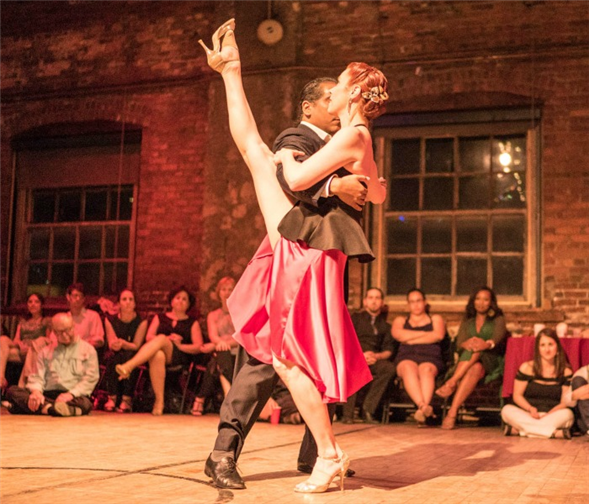Translate Page

A tanguera explains why the dance inspires so many international adventures
---
No other form of dance embodies our globalized lives as Argentine tango does. It thrives on a tension that is of this moment. The product of immigrant populations who met on the outskirts of Buenos Aires in the late 1800s, tango remains utterly tied to its origins. The Argentine capital attracts millions of dancers and dollars annually to a scene that never sleeps, where tangueros (tango aficionados) can live and breathe the dance, night and day. Meanwhile, outside the dance's birthplace, tango festivals engineer the onda (vibe) of Buenos Aires. These multi-day events draw attendees from across borders, and offer fans the chance to study with maestros (master teachers) and partake in milongas (social dances) until the sun rises. I recently attended the 7th Philadelphia International Tango Festival at the city's historic German Society building, and experienced this cosmopolitan community firsthand.
The setting highlighted an interesting German-tango connection. The form's forebears include freed African slaves, displaced gauchos (cowboys), and various European immigrant groups including Germans, who introduced the bandoneon, the instrument responsible for tango's signature melancholy sound. During the open-air milonga in the Leidy Terrace garden -- which recalls Buenos Aires' famous alfresco tango site La Calesita -- attendees could admire a piece of the Berlin Wall The John Horner Library, a stunning 19th-century reading room flanked by busts of famous German figures, served as the perfect backdrop for the meeting of old and new that is "alternative tango" -- the practice of dancing to non-traditional music. Even the basement-level Ratskeller, designed after German beer taverns, evoked the casual, early 20th-century charm of porteño (port city) bars of Buenos Aires, an effect completed by the menu of Argentine staples such as empanadas, medialunas (croissants), and milanesas.
The international teaching staff enhanced the festival's global atmosphere. Beloved Argentine maestros Nito Garcia and Elba Sottile headlined, transporting the room to the dance's golden age. Over the course of 40 years, the couple has spread the gospel of tango around the world. Their regal performance showed why dancers spend a lifetime pursuing tango's walk, while their dramatic, playful partnering could be an ad for the lifelong benefits of partner dancing. At once beacons of tango's new generation and 20-year veterans, Alejandra Hobert and Adrian Veredice have starred in countless touring productions. Their jaw-dropping performance blended the sinuous athleticism of contemporary stage tango with the heart and soul of a pair still enamored of the dance -- and one another. Arguably the most prominent female pedagogue associated with tango innovations in the 1990s and early 2000s, Carla Marano is internationally renowned for her women's technique workshops, and a sought-after instructor in Argentina and abroad. With partner Andres Amarilla -- who began doing tango as a child in 1980s Buenos Aires -- festival organizer Meredith Klein danced a romantic, ballet-infused interpretation of Debussy's "Clair de lune." Similarly, Marcelo "el Chino" Gutierrez and NYC-based Cigdem Tanik gave an impassioned performance that illuminated the ever-present interaction between old and new in tango.
The weekend as a whole reminded me of tango's global embrace as I reconnected with friends from Philadelphia and beyond who trace their roots far and wide -- to Argentina, India, Turkey, Italy, China, Brazil, England, Chile, Portugal, Sweden, Korea, and more. On the dance floor, I met a visitor from Texas who was in the midst of a Northeast tango trip culminating with the Toronto festival. This encounter recalled my own pre-parenthood travels in tango, when a cheap bus trip was all that separated me from a weekend of dancing in New York's Central Park or at the city's myriad dance studios, social clubs, bars and restaurants hosting milongas, classes and prácticas (practice events).
This summer I plan to break in my new Bandolera shoes from Italy. I'm calculating the costs of overnight babysitting and a stay at NYC tango guesthouse La Cumparsita, and scanning the calendar for upcoming workshops with visiting teachers: Monica Paz, Nito and Elba, Guillermina Quiroga, Claudio Gonzalez, Fabian Salas, Johanna Copes -- and that's just through July in New York! I could also pack my bags, passport, and tango shoes, pick almost any city in the world, arrive and search the web for the milonga that night. Soon I'd find myself amidst a whole new group of tangueros, joyously expanding my global tango family.
---
An anthropologist and tango enthusiast, Carolyn Merritt wrote the book Tango Nuevo.
TDF Members: Go here to browse our discounts for dance, theatre, and concerts.
Top image: Andres Amarilla and Meredith Klein. Photos by Helio Ha.